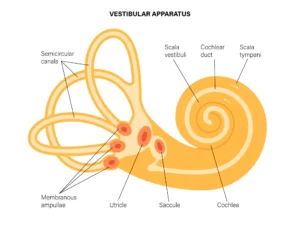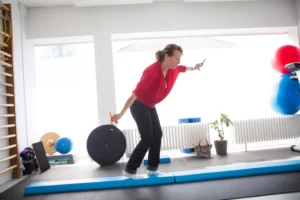Who Is A Vertigo Specialist?
The majority of causes of vertigo develop from the ear, hence ear, nose and throat – ENT Specialists are experts in the management of vertigo.
Do I Have Vertigo? What Is Vertigo?
Vertigo is a symptom, rather than a condition itself. It’s the sensation that you, or the environment around you, is moving or spinning. This feeling may be barely noticeable, or it may be so severe that you find it difficult to keep your balance and do everyday tasks.
What Is Dizziness?
 Everyone has a dizzy spell now and then, but the term “dizziness” can mean different things to different people. Dizziness is a term used to describe a range of sensations, such as feeling faint, woozy, weak or unsteady. For one person, dizziness might mean a fleeting feeling of faintness, while for another it could be an intense sensation of spinning (vertigo) that lasts a long time. It is important to note that not all dizziness is ‘vertigo’.
Everyone has a dizzy spell now and then, but the term “dizziness” can mean different things to different people. Dizziness is a term used to describe a range of sensations, such as feeling faint, woozy, weak or unsteady. For one person, dizziness might mean a fleeting feeling of faintness, while for another it could be an intense sensation of spinning (vertigo) that lasts a long time. It is important to note that not all dizziness is ‘vertigo’.
Dizziness can be caused by certain health conditions, medications, or a problem in the inner ear or the brain. Dizziness can profoundly affect daily activities and cause severe psychological fear and emotional issues.
What Are The Signs And Symptoms Of Dizziness?
If you have dizziness, your symptoms might include:
- Vertigo (a spinning sensation)
- Falling or feeling as if you are going to fall
- Staggering when you try to walk
- Lightheadedness, faintness, or a floating sensation
- Blurred vision
- Confusion or disorientation
- Other symptoms might include nausea and vomiting; diarrhea; changes in heart rate and blood pressure; and fear, anxiety, or panic.
Symptoms may come and go over short time periods or last for a long time, and can lead to fatigue and depression.
How Does My Body Keep Its Balance?
 Your sense of balance relies on a series of signals to your brain from several organs and structures in your body, specifically your eyes, ears, and the muscles and touch sensors in your legs. The part of the ear that assists in balance is known as the vestibular apparatus, or the labyrinth, a maze-like structure in your inner ear made of bone and soft tissue. This balance organ is adjacent to the cochlea, the organ of hearing.
Your sense of balance relies on a series of signals to your brain from several organs and structures in your body, specifically your eyes, ears, and the muscles and touch sensors in your legs. The part of the ear that assists in balance is known as the vestibular apparatus, or the labyrinth, a maze-like structure in your inner ear made of bone and soft tissue. This balance organ is adjacent to the cochlea, the organ of hearing.
Within the labyrinth are structures known as semicircular canals. The semicircular canals contain three fluid-filled ducts, which form loops arranged roughly at right angles to one another. They tell your brain when your head rotates. Inside each canal is a gelatin-like structure called the cupula stretched like a thick sail that blocks off one end of each canal. The cupula sits on a cluster of sensory hair cells. Each hair cell has tiny, thin extensions called stereocilia that protrude into the cupula.
When you turn your head, fluid inside the semicircular canals moves, causing the cupulae to flex or billow like sails in the wind, which in turn bends the stereocilia. This bending creates a nerve signal that is sent to your brain to tell it which way your head has turned.
Between the semicircular canals and the cochlea lie two otolithic organs: fluid-filled pouches called the utricle and the saccule. These organs tell your brain the position of your head with respect to gravity, such as whether you are sitting up, leaning back, or lying down, as well as any direction your head might be moving, such as side to side, up or down, forward or backward.
The utricle and the saccule also have sensory hair cells lining the floor or wall of each organ, with stereocilia extending into an overlying gel-like layer. Here, the gel contains tiny, dense grains of calcium carbonate called otoconia. Whatever the position of your head, gravity pulls on these grains, which then move the stereocilia to signal your head’s position to your brain. Any head movement creates a signal that tells your brain about the change in head position.
When you move, your vestibular system detects mechanical forces, including gravity, that stimulate the semicircular canals and the otolithic organs. These organs work with other sensory systems in your body, specifically your eyes, ears, and the muscles and touch sensors in your legs, to control the position of your body at rest or in motion. This helps you maintain stable posture and keep your balance when you’re walking or running. It also helps you keep a stable visual focus on objects when your body changes position.
When the signals from any of these sensory systems malfunction, you can have problems with your sense of balance, including dizziness or vertigo. If you have additional problems with motor control, such as weakness, slowness, tremor, or rigidity, you can lose your ability to recover properly from imbalance. This raises the risk of falling and injury.
What Are The Causes Of Vertigo?
The causes of vertigo are numerous, and are elaborated on below:
Benign Paroxysmal Positional Vertigo (BPPV)
BPPV is a brief, intense episode of vertigo triggered by a specific change in the position of the head. You might feel as if you’re spinning when you bend down to look under something, tilt your head to look up or over your shoulder, or roll over in bed. BPPV occurs when loose otoconia tumble into one of the semicircular canals and affect how the cupula works. This keeps the cupula from flexing properly, sending incorrect information about your head’s position to your brain, and causing vertigo. BPPV can result from a head injury, or can develop just from getting older. Making the BPPV diagnosis is fairly simple and is based on history and physical examination.
Vestibular Neuronitis / Labyrinthitis:
Vestibular Neuronitis is an infection or inflammation of the inner ear that causes dizziness and loss of balance. When it is associated with hearing loss, it is instead termed Labyrinthitis. It is often associated with an upper respiratory infection, such as the flu.
Ménière’s Disease:
Ménière’s disease consists of episodes of vertigo, hearing loss, tinnitus (a ringing or buzzing in the ear), and a feeling of fullness in the ear. It may be associated with a change in fluid volume within parts of the labyrinth, but the cause or causes are still unknown.
Perilymph Fistula:
Perilymph fistula is a leakage of inner ear fluid into the middle ear. It causes unsteadiness that usually increases with activity, along with dizziness and nausea. Perilymph fistula can occur after a head injury, dramatic changes in air pressure (such as when scuba diving), physical exertion, ear surgery, or chronic ear infections. Some patients are born with perilymph fistulae.
Mal de Debarquement Syndrome:
This syndrome leads to a feeling of continuously rocking, swaying, or bobbing, typically after an ocean cruise or other sea travel, or even after prolonged running on a treadmill. Usually the symptoms go away within a few hours or days after you reach land or stop using the treadmill. Severe cases, however, can last months or even years, and the cause remains unknown.
Vestibular Migraine
Migraine headaches are a common neurological condition. Although common migraines are characterized by a moderate to severe pounding or throbbing headache, vestibular migraine may or may not involve headaches in combination with vestibular symptoms such as vertigo, imbalance, nausea and vomiting.
Vestibular migraine can cause vestibular or balance symptoms with or without an actual headache.
There is almost always a history of motion sensitivity (such as car sickness) since childhood, and migraine headaches at some point in the person’s lifetime, even if they last occurred decades ago.
Vestibular migraine is not fully understood but seems to result from overlapping pathways that modulate pain and vestibular inputs into the brain. Many of the triggers for migraine headaches can cause a vestibular migraine.
How Are The Causes Of Vertigo Diagnosed?
Diagnosis of the cause of vertigo can be difficult. To find out if you have symptoms of vertigo, you may want to consult an ENT specialist.
You may be asked to participate in a hearing examination, blood tests, a video nystagmogram (a test that measures eye movements and the muscles that control them), or imaging studies of your head and brain if a more serious condition such as a stroke is suspected.
What Is Available For Vertigo Treatment In Singapore?
Vertigo treatment in Singapore requires comprehensive history and physical examination. The first thing an ENT specialist will do if you have dizziness is to determine if another health condition or a medication is to blame for your symptoms. If so, your doctor will treat the condition, suggest a different medication, or refer you to a specialist if the condition is outside his or her expertise.
If you have BPPV, a series of simple movements, such as the Epley maneuver, may help to dislodge the otoconia from the semicircular canal. In many cases, one session works; other people need the procedure several times to relieve their dizziness. Patients often ask: ‘can BPPV go away on its own’? Once the otoconia returns to its original position, the dizziness will improve. The aim of the Epley maneuver is to return the otoconia back to its original position quickly and thus relieve the symptoms of vertigo.
If you are diagnosed with Ménière’s disease, you may need to make some changes to your diet and, if you are a smoker, that you stop smoking. Anti-vertigo or anti-nausea medications may relieve your symptoms, but they can also make you drowsy. Other medications, such as gentamicin (an antibiotic) or corticosteroids may be used in the ear. Although gentamicin may reduce dizziness better than corticosteroids, it occasionally causes permanent hearing loss. In some very severe cases of Ménière’s disease, surgery on the vestibular organs may be needed.
Some people with these symptoms may not be able to fully relieve their dizziness and will need to find ways to cope with it. Vertigo medication can help in the acute phase. For some patients, vestibular rehabilitation can help in providing long term relief and prevention of some of these symptoms.
Activities such as driving or climbing heights may need to be curtailed to lower your risk of falling and getting hurt during daily activities. Patients often ask: “What is the best treatment for vertigo?” Unfortunately, there are no one-size-fits-all answer to this question. There are some medications for vertigo treatment at home but this needs to be discussed with your doctor.
What Is Vestibular Rehabilitation?
 Vestibular rehabilitation is a specialized form of vestibular physiotherapy intended to alleviate both the primary and secondary problems due to vestibular disorders. It is an exercise-based program primarily designed to reduce vertigo and dizziness, reduce gaze instability, and/or reduce imbalance and fall risk as well as address any secondary impairments that are a consequence of the vestibular disorder.
Vestibular rehabilitation is a specialized form of vestibular physiotherapy intended to alleviate both the primary and secondary problems due to vestibular disorders. It is an exercise-based program primarily designed to reduce vertigo and dizziness, reduce gaze instability, and/or reduce imbalance and fall risk as well as address any secondary impairments that are a consequence of the vestibular disorder.
For most people who have a vestibular disorder, the deficit is permanent because the amount of restoration of vestibular function is very small. However, after vestibular system damage, symptoms can reduce and function can improve because of compensation. This occurs because the brain learns to use other senses (vision and somatosensory (body sense)) to substitute for the deficient vestibular system. For many, compensation occurs naturally over time, but for patients whose symptoms do not reduce and who continue to have difficulty returning to daily activities, vestibular rehabilitation can assist in recovery by promoting compensation.
The goal of vestibular rehabilitation is to use a problem-oriented approach to promote compensation. This is achieved by customizing exercises to address the specific problems of each individual. Depending on the vestibular-related problems identified, three principal methods of exercise can be prescribed:
- Habituation,
- Gaze Stabilization
- Balance Training
Habituation
Habituation exercises are used to treat symptoms of dizziness that is produced because of self-motion and/or produced because of visual stimuli. Habituation exercises are indicated for patients who report increased dizziness when they move around, especially when they make quick head movements, or when they change positions like when they bend over or look up to reach above their heads. Also, habituation exercise is appropriate for patients who report increased dizziness in visually stimulating environments, like shopping malls and grocery stores, when watching action movies or T.V., and/or when walking over patterned carpets and shiny floors. The goal of habituation exercises is to reduce the dizziness through repeated exposure to specific movements or visual stimuli that provokes patients’ dizziness. These exercises are designed to mildly, or at the most, moderately provoke the patients’ symptoms of dizziness. Over time, with good compliance and perseverance, the dizziness intensity can reduce as the brain learns to ignore the abnormal signals.
Gaze Stabilization
Gaze Stabilization exercises are used to improve control of eye movements to keep vision clear during head movement. These exercises are appropriate for patients who report problems seeing clearly because their visual world appears to bounce or jump around, such as when reading or when trying to identify objects in the environment, especially when moving about.
Balance Training
Balance Training exercises are used to improve steadiness so that daily activities for self-care, work, and leisure can be performed successfully. Exercises used to improve balance are designed to address each patient’s specific underlying balance problems. Also, to promote changes in balance, the exercises need to be moderately challenging, but safe enough so patients do not fall while doing them.
Additionally, balance exercises should be designed to reduce environmental barriers and fall risk. For example, the exercises should help improve patients’ ability to walk outside on uneven ground or walk in the dark.
What Cures Vertigo Fast? When Should I Seek Help For Vertigo?
Cures for vertigo are dependent on the cause. For example, patients with benign postural paroxysmal vertigo (BPPV) can experience significant quick improvement after an Epley manoeuvre. Patients who are diagnosed with vestibular neuronitis may require weeks of vestibular rehabiliation before experiencing improvement in their vertigo symptoms.
To help you decide whether to seek medical help for dizziness or balance problems, ask yourself the following questions:
- Do I feel unsteady?
- Do I feel as if the room is spinning around me, even for a very brief time?
- Do I feel as if I’m moving when I know I’m sitting or standing still?
- Do I lose my balance and fall?
- Do I feel as if I’m falling?
- Do I feel lightheaded or as if I might faint?
- Do I have blurred vision?
- Do I ever feel disoriented—losing my sense of time or location?
See a vertigo specialist in Singapore, or an ENT specialist to evaluate your condition and undergo vertigo treatment in Singapore. Cure your vertigo fast!
References:
Table of Content
- Do I Have Vertigo? What is Vertigo?
- What is Dizziness?
- What are the signs and symptoms of Dizziness?
- How does my body keep its balance?
- What are the causes of Vertigo?
- How are the causes of Vertigo diagnosed?
- What is available for Vertigo treatment in Singapore
- What is Vestibular Rehabilitation?
- What cures Vertigo fast?








